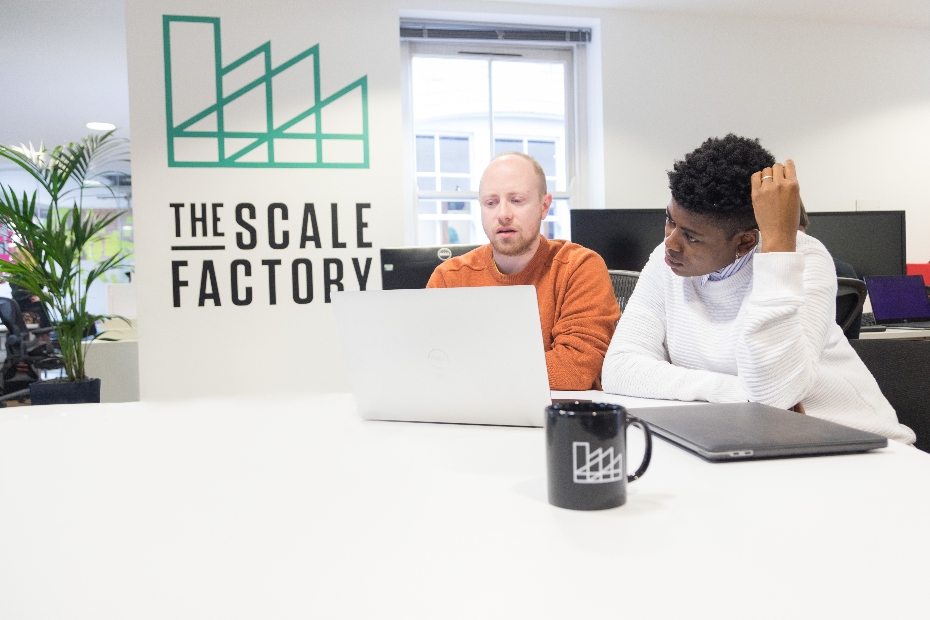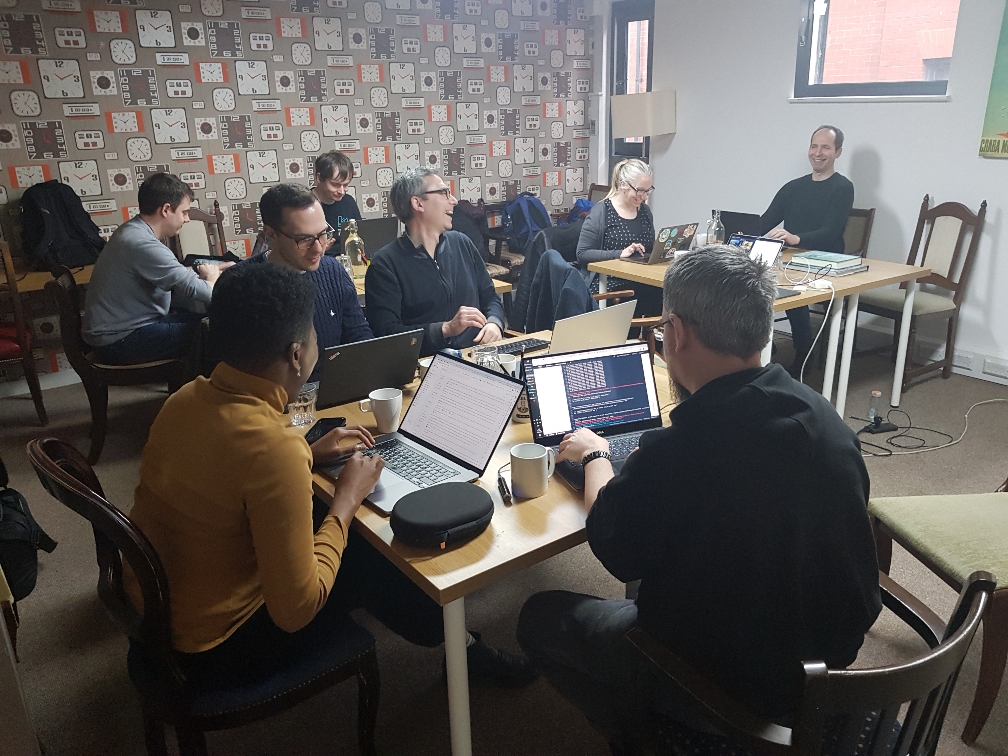Please note that this post, first published over a year ago, may now be out of date.
I recently volunteered to be a technical interviewer for a coding charity. I introduced myself as a cloud consultant, and one of the interviewees was interested to know how a typical day in my work life looks like. In the interview I could only give a brief answer but I wanted to explain more about what this role involves. This in turn led me to writing this blog post. To bring in more than one perspective, I chatted to my colleague Sandro - I’ll call out how he structures his day differently to mine.

Pairing with a colleague during All-Hands
No two days at The Scale Factory are the same - I might be working with one customer for a few weeks, then by the following week I might move on to a different project, or focus on helping customers that have a support subscription.
Helping clients through support & learning means dealing with interesting challenges, and guiding our clients to get them solved. That kind of work brings exciting opportunities to work on different technology stacks; it also means it’s really important to be able to switch to a different context quickly, perhaps to a part of a customer’s systems that you haven’t touched before.
Keeping our internal documentation current and accurate really matters, as every client’s infrastructure is unique. Without those documents as a coordination point, it would be a real challenge to remember how to log in, where to look, and how to troubleshoot issues when the time arises. Whether I’m advising someone on a tricky bit of Terraform, reviewing a customer’s estate, or embedded into a project, I’m always using my cloud technology skills.
The Beginning
My work day usually starts with a notepad and a pen. Trust me, I have tried using other productivity apps but none of them does the job for me as well as a notepad, nothing matches the feeling of checking an item off my list. I would physically write a To Do list of all tasks I plan on working on (both work and personal). This method has been my go-to way of clearing out my head in the morning, removes any anxiety that may arise from forgetting anything important, and helps me get ready to start the day.
Team Rituals
Next will be getting online on Slack, checking channels that have important announcements and replying to any direct messages and emails I may have missed from the previous day as well as make post on our #belvita Slack channel. That’s where we post what we did the previous day and what we plan on achieving today. It is a good way of letting my colleagues know if I am stuck on a task and need a fresh pair of eyes or someone to bounce my ideas off.
My colleague Sandro sketches his #belvita update for tomorrow in a text file at the end of his working day to list the tasks he worked on and what he plans to do the following day. Then each morning he posts the message to Slack directly from his text editor using a vim-slack integration that our former colleague Paul wrote.
The Tasks
This usually depends on whether I am working with a customer or on the bench (not actively being involved with a specific customer). This is when I am most active on picking up support queries. I might also spend that time contributing to training session content, working on internal tooling, writing a blog post, or studying for an AWS exam. When I am on a client’s project the dynamics change slightly - my day pivots, based on whatever standup cadence they have in place, which is usually set at the start of the project. Most of the clients I have been fortunate to work with would prefer us to be integrated with the team whether by joining daily standups, sprint planning or project update meetings.
Depending on the project, my tasks may include anything from full on engineering (for example: building CI/CD pipelines, writing code for Lambdas) to investigative tasks such as cost optimization, ensuring workload performance, or analysing information security risks.

A co-working day in Manchester
Time Boxing
This is a new technique I have been trying out lately to see if I can complete a task within a certain timeframe. I have realized blocking out time to complete a task is giving me more visibility into how much time I may need to complete a similar task in the future and also makes it easy to log in time on our time tracking tool (we use Harvest) which helps the management team determine how much of my time to allocate for future projects.
Personal Growth
We work in an industry where things are constantly changing. As a consultant I enjoy learning new technologies, sharpening my skills in order to meet up with industry developments. I find it difficult incorporating some study time into my day when I am on a client’s project - I’d rather wrap up the project and book some development days to study for exams or learn something new. Sandro on the other hand finds it easier to incorporate some personal development tasks (such as catching up on AWS blogs, reading white papers, or preparing for an AWS exam) into his daily routine as it works best for him to do a little each day.
Updating Personal Documentation
Even though we have a robust internal documentation, I find it more productive having my own personal notes. When troubleshooting I tend to save some of my most used commands and steps for quick access when next I am working on a similar issue before looking at our internal pages. Command line history and browser bookmarks are useful too, but my own notes provide context that I can quickly review if I need to. If I’ve encountered a new technique or technology whilst helping a customer, I’ll update my personal notes with any handy command line snippets, and an outline of the steps I took.
Also, speaking to my colleague Sandro about this topic, it turns out he has an automated way of updating his personal documentation. He uses OneNote, hooked up to a personal cloud services provider with a cron job that saves his file every couple of minutes.
Keeping in touch with colleagues
For me, it is sometimes too easy to get drawn into a client’s project and forget to check in on company updates and my colleagues. Ideally I can find a good balance between client-specific work and the company’s internal activities. The social side of interacting with my team matters too. What I’ve realised is that I sometimes have to consciously plan to make time for this. My colleague Sandro handles that challenge pretty well by adding a task specifically for The Scale Factory to his daily #belvita plan (for example: to spend 20 minutes reviewing internal PRs, or updating internal documentation), so that he is not out of touch with this kind of work.
End of day
Depending on what day of the week it is, I love joining in on internal activities such as:
- Tech study groups where we discuss and share knowledge about a particular technology, pros, cons and use cases.
- Consultancy study groups where we discuss interesting topics that go a long way to hone my consulting skills. This can be on anything ranging from active listening to conflict resolution.
Before logging out, I’d usually have a quick look at my to-do list and make a mental note about tasks that were not finished (if any) to be carried over to the next day.
Working in cloud solution architecture is quite varied, there’s never a typical day. I hope it gave you a flavour of what we do as consultants.
We’ve been an AWS SaaS Services Competency Partner since 2020. If you’re building SaaS on AWS, why not book a free health check to find out what the SaaS SI Partner of the Year can do for you?
This blog is written exclusively by The Scale Factory team. We do not accept external contributions.
